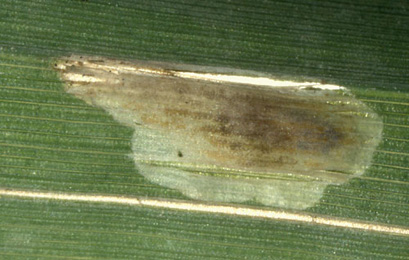|
||||||
|
STRATIOTES. Water-soldier. [Hydrocharitaceae] |
|
Water-soldier (S. aloides) is the only species of Stratiotes recorded in Britain. Three British miners are recorded on Stratiotes. A key to the European miners recorded on Stratiotes is provided in Bladmineerders van Europa. |
Key for the identification of the known mines of British |
1a > ? Leaf-miner: A number of short, rather broad corridors that enter the blade from the midrib. Pupation within the mine, mainly in the leaf base and the midrib. At the moment only adult flies can be separated from H. stratiotae.. |
|
Hydrellia mutata (Zetterstedt, 1846) [Diptera: Ephydridae]. |
1b > Leaf miner: Irregular mine, locally shallow, elsewhere much deeper, giving it a mottled appearance. In broadleaved plants the mine often begins as a blotch with stellate extensions, but sometimes as a very fine, shallow corridor. In grasses the mine often begins in the leaf sheath. The frass is very fine-grained, initially scattered, later in aggregates. The egg is deposited on the plant surface, and the empty egg shell remains visible. But the larvae are able to leave their mine and restart elsewhere, thus mines without an egg shell can be found as well. The larva also leaves the mine before pupation. Pupation takes place in a newly made, small, blotch mine without frass; this mine may be made in another plant (species). |
 Mine of Hydrellia griseola on Glyceria fluitans Image: © Willem Ellis (Bladmineerders van Europa) |
|
Hydrellia griseola (Fallén, 1813) [Diptera: Ephydridae]. |
1c > Leaf-miner: Makes short, straight mines, with little frass. The larva crosses from leaf to leaf through the stem. It pupates in the stalk, rarely in the leaf. |
|
Hydrellia cochleariae Haliday, 1839 [Diptera: Ephydridae]. |
| Last updated 07-Jul-2019 Brian Pitkin | ||
